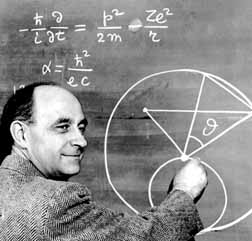 |
|
The Last Universal Physicist by Chris Quigg
 On the occasion of his one hundredth birthday, we honor a great scientist who was born in Italy, made immense and lasting contributions to the birth of modern physics, and emigrated to the United States, where he carried out experiments and theoretical studies that ushered in the atomic age.
On the occasion of his one hundredth birthday, we honor a great scientist who was born in Italy, made immense and lasting contributions to the birth of modern physics, and emigrated to the United States, where he carried out experiments and theoretical studies that ushered in the atomic age.
Enrico Fermi was born in Rome on September 29, 1901, and received his doctorate from the University of Pisa in 1922. After fellowships in Göttingen and Leiden, he lectured for two years at the University of Florence. In 1927, Fermi was elected the first professor of theoretical physics at the University of Rome, where he attracted a brilliant group of students and collaborators. The scientific work of Fermi and his circle influenced an astonishing range of topics, many of which are of high interest in the year 2001. An uncanny instinct for the most important questions and a remarkable gift for simple, direct explanations are hallmarks of Fermi's contributions. Scientists hold him in awe as "the last universal physicist." In a lifetime of scientific achievement, Enrico Fermi's work on neutrons and radioactivity had perhaps the broadest impact. Following the observation of artificial radioactivity, Fermi found that nuclear transmutation occurs in nearly every element bombarded by neutrons. That work led him to discover the special effectiveness of slow neutrons for inducing nuclear transformations, which in turn led to the discovery of nuclear fission and the production of artificial elements. Enrico Fermi was awarded the 1938 Nobel Prize in Physics for his neutron research. He and his family used the occasion of the Nobel ceremony to escape the tightening grip of fascism; he joined the tide of illustrious immigrants who transformed the American scientific community, taking a professorship at Columbia University. In the discovery of fission, Fermi saw the possibility that the emission of secondary neutrons could sustain a chain reaction. With tremendous enthusiasm and his characteristic clarity of thought, he directed a series of classic experiments that eventually led to the atomic pile and the first controlled nuclear chain reaction, observed by his team on December 2, 1942 in Chicago. Fermi became an American citizen in 1944. For the next two years, he served as Associate Director of the Los Alamos Scientific Laboratory in New Mexico, and was among the witnesses to the first nuclear explosion in the Alamogordo desert. At the end of the war, Fermi accepted a position at the Institute for Nuclear Studies at the University of Chicago, where he established another great school of physics. Until his death in 1954, his main scientific interest was in the new field of particle physics. Fermi's contributions to science, teaching, and public service make him a continuing inspiration to other scientists and to young people today. His name lives on in the Enrico Fermi Institute at the University of Chicago, where the range of superb scientific research carries on his legacy; the Fermi National Accelerator Laboratory (Fermilab), in Batavia, Illinois, the particle physics laboratory that is home to the world's most powerful accelerator; and the Fermi Award, a Presidential award that is one of the oldest and most prestigious science and technology honors given by the United States government. At Fermilab this week, we commemorate the life and work of this outstanding scientist and great American citizen. On the Web:
|
| last modified 9/30/2001 by C. Hebert email Fermilab |
FRLsDFx9eyfrPXgV